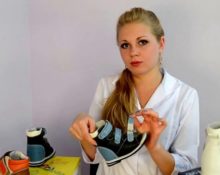 The health of not only the joints, but also the entire spinal column depends on how comfortable and high-quality shoes are worn every day. In addition, if the foot already has a certain deformation, then when purchasing it is necessary to carefully select the model. In order for the purchased pair to deliver not only comfort, but also aesthetic pleasure, it is necessary to pay attention to a set of parameters, ranging from technological characteristics to the manufacturer.
The health of not only the joints, but also the entire spinal column depends on how comfortable and high-quality shoes are worn every day. In addition, if the foot already has a certain deformation, then when purchasing it is necessary to carefully select the model. In order for the purchased pair to deliver not only comfort, but also aesthetic pleasure, it is necessary to pay attention to a set of parameters, ranging from technological characteristics to the manufacturer.
How to choose shoes for women with a bunion on their foot
Shoes should be comfortable, especially if they are intended for everyday wear. But if there are certain deformities and defects on the feet, then comfort is the main starting point when buying a pair.
So, you will have to select a special product, taking into account the problems, in cases where there are:
- Valgus deformity around the big toe (that is, the bone bulges out).
- Flat feet or, conversely, too much arching in the instep.
- The presence of calluses or corns, both on the fingers and on the foot.
- Recent injuries or, for example, surgery on a bone, after which the musculoskeletal structures of the foot have not yet fully recovered.
All of the above is a reason to pay attention to:
Size range with extended parameters. In this case, the shoe size is selected not only according to the length of the foot, but also the height of the instep and fullness.
The fullness of shoes can be normal, medium and large. It is selected if the foot is quite full, swollen or deformed. In addition, increased fullness may be needed during the recovery period after bunion surgery or other types of surgery.
IMPORTANT! If the foot is severely deformed, then you will also have to opt for fuller models.
Availability of insoles and instep support. These elements in the design help the correct formation of all deflections of the foot. They are not allowed to be changed. That is, they maintain the correct anatomical shape. Sometimes there are various bulges on the insole that have a massage effect.
Sole materials that provide an “anti-stress” effect. The use of special materials for the manufacture of shoe soles allows the foot to bend comfortably in the right places. In addition, a so-called “springy” gait is ensured. In this case, the greater effect is on the spinal column. This happens due to less impact load on the intervertebral discs.
Heels. Most people know that high heels negatively affect not only the spine, but also the shape of the foot. But its absence will also be negative. The best option is a heel about 3 cm in height and wide at the base, ensuring a stable position for the entire body.
IMPORTANT! When buying shoes for a foot that has a bump, keep in mind that there should be no seams in this area, both external and internal. Otherwise, the couple will rub the sore spot.
 In addition to technological aspects, it is also worth paying attention to the fact that in the modern shoe market there are manufacturers who focus on ergonomics and comfort. These include:
In addition to technological aspects, it is also worth paying attention to the fact that in the modern shoe market there are manufacturers who focus on ergonomics and comfort. These include:
Rieker is a German shoe brand that uses special, patented technologies that provide maximum comfort and anatomical support for the foot structure.
Gabor is also a German shoe manufacturer, distinguished by particular care in the development of the entire design. Each model has more than 200 individual elements. Moreover, they are sewn together in such a way that as a result no dents or creases are formed. The models of this company are distinguished by the presence of large fullness (the so-called fullness G) and extra-fullness, which is marked as H. Also, many models are equipped with special elastic bands, lacing, elastic inserts and buckles.
How to stretch your shoes so that the bump doesn't put pressure on you?
 If the purchased shoes still press in certain places, then you can try to stretch them.
If the purchased shoes still press in certain places, then you can try to stretch them.
IMPORTANT! This can only be done for genuine leather products. Moreover, it is worth paying attention to the fact that leather and suede products stretch well, while varnish products stretch with difficulty.
You can do this in the following ways:
Put a sock on your foot. Spray the inside of the shoes with a special stretcher. Then put on a pair and stay in it for a while so that the skin takes the desired size and locks in place.
If there is no special stretch, then you can put the shoes on the toe, placing a rag soaked in diluted alcohol or vinegar on top.
REFERENCE! If it is difficult to put shoes on the toe due to existing deformations, then you should ask someone with the same or slightly larger foot size to do it.


 2
2





